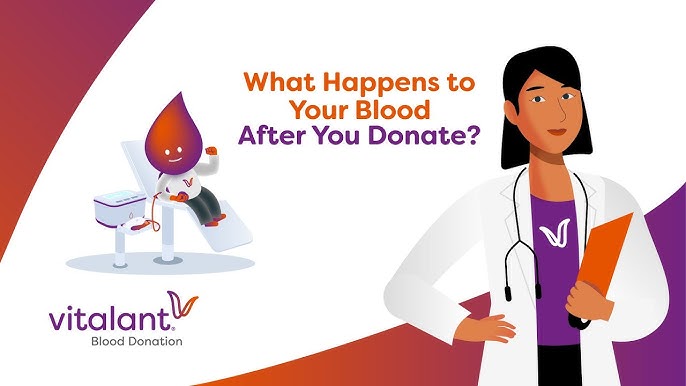Every year, millions of generous donors roll up their sleeves to give blood — a simple, life-saving act that takes just a few minutes. But have you ever wondered what happens to your blood after it leaves your arm? Where does it go? How is it used? And how quickly does it reach someone in need?
In this detailed guide, we’ll explain the entire journey your blood takes after donation, from collection to transfusion. Whether you’re a first-time donor or a regular contributor, this behind-the-scenes look will make you appreciate the incredible system that saves countless lives every day.
Why Blood Donation Matters
Blood donations are vital for:
-
Accident and trauma victims
-
Surgical procedures
-
Cancer patients undergoing treatment
-
Premature babies
-
Individuals with chronic blood disorders like sickle cell anemia and hemophilia
One donation can save up to three lives because your blood is separated into different components — red cells, plasma, and platelets — each serving a unique medical purpose.
👉 You can learn more about blood types and compatibility on Red Cross Blood Services.
What Happens Immediately After You Donate Blood?
Once you’ve completed your blood donation (usually around 470–500ml or about one pint), the collection process kicks off immediately.
Step 1: Labeling and Documentation
Each unit of donated blood is:
-
Labeled with a unique barcode and serial number
-
Tagged with the donor’s blood type and donation date
-
Recorded for traceability and tracking
This labeling ensures that your blood can be safely monitored and matched to compatible recipients.
Step 2: Transport to Blood Processing Center
Within a few hours of collection, the blood is transported under strict temperature-controlled conditions to a blood processing center. Maintaining the correct storage temperature (typically 1°C–6°C for whole blood) is crucial for safety and viability.
Fact: In large cities, donations often reach processing centers the same day.
Step 3: Blood Testing
Before your blood is approved for use, it undergoes rigorous screening tests for:
-
Blood type (A, B, AB, O and Rh factor)
-
Infectious diseases like:
-
HIV
-
Hepatitis B and C
-
Syphilis
-
HTLV (Human T-Lymphotropic Virus)
-
Malaria (in some regions)
-
If any test is positive, the unit is safely discarded, and the donor is confidentially notified.
For more about safety regulations, visit the World Health Organization’s blood safety guidelines.
Step 4: Separation Into Components
Whole blood isn’t typically transfused as-is. Instead, it’s separated into three primary components using a process called centrifugation:
-
Red Blood Cells (RBCs): Carry oxygen throughout the body; used in surgeries, trauma care, and for anemia.
-
Platelets: Help blood clot and stop bleeding; essential for cancer and leukemia patients.
-
Plasma: The liquid part of blood containing proteins and clotting factors; used in burn treatment, trauma care, and clotting disorders.
This separation allows one donation to benefit multiple patients with different medical needs.
Step 5: Storage
After separation, each component is stored under specific conditions:
| Component | Storage Temp | Shelf Life |
|---|---|---|
| Red Blood Cells | 1°C–6°C | 35–42 days |
| Platelets | 20°C–24°C (with constant agitation) | 5–7 days |
| Plasma (frozen) | -18°C or colder | Up to 1 year |
Proper storage ensures the safety and effectiveness of each component until it’s needed.
Step 6: Matching to a Patient
When a hospital sends a blood request — say, for a surgery or trauma patient — the blood bank searches its inventory for a compatible blood type and cross-matches it with the recipient’s blood.
Cross-matching is an additional safety step where a small sample of the donor’s and patient’s blood are mixed in the lab to confirm compatibility and prevent adverse reactions.
Step 7: Distribution and Transfusion
Once compatibility is confirmed:
-
Blood units are packed in temperature-controlled transport boxes
-
Delivered to hospitals or clinics
-
Transfused to the patient within hours or days, depending on urgency
Fact: In emergencies, blood can reach a hospital and be transfused in less than 4–6 hours after collection.
What Happens to Leftover or Expired Blood?
Blood products have expiry dates, and blood banks strive to use them promptly. If blood expires:
-
Red blood cells may be turned into research material or disposed of safely.
-
Plasma can be fractionated into plasma-derived medicines like immunoglobulins or clotting factors.
-
Platelets past their shelf life are typically discarded.
Nothing is wasted without good reason, as blood is a precious, life-saving resource.
How Often Can You Donate Blood?
-
Whole blood: Every 8 weeks (56 days)
-
Platelets: Every 2 weeks (up to 24 times a year)
-
Plasma: Every 28 days
Check your country’s donation guidelines via organizations like:
Also Check
- 5 Donation Scams to Watch Out for and How to Avoid Them
- How to Organize a Community Fundraiser: Step-by-Step Guide (2025)
- 5 Ways to Support Blood Donation Campaigns Near You
- How to Donate Safely to International Disaster Relief Funds (2025 Guide)
- Insurance Claim Denied? How to Appeal a Decision the Right Way
Final Thoughts: Your Blood Donation Saves Lives
When you donate blood, you’re not just giving a pint — you’re providing hope, strength, and a second chance at life. Behind the scenes, a dedicated network of healthcare professionals, scientists, and volunteers work tirelessly to ensure your donation reaches those in desperate need.
Understanding the full journey of your blood can deepen your appreciation for the donation process and inspire you to become a regular donor.
